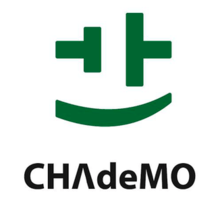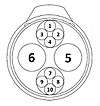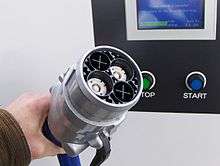CHAdeMO
 | |
 Charging station socket | |
| Formation | 2010 |
|---|---|
| Purpose | CHAdeMO Association aims to increase quick-charger installations worldwide and to standardize how to charge the vehicles. |
| Website | http://chademo.com |

CHAdeMO is the trade name of a quick charging method for battery electric vehicles delivering up to 62.5 kW by 500 V, 125 A direct current[1] via a special electrical connector. A revised CHAdeMO 2.0 specification allows for up to 400 kW by 1000 V, 400 A direct current.[2]
It is proposed as a global industry standard by an association of the same name[3] and included in IEC 62196 as type 4. Competing standards include the Combined Charging System and the Tesla Supercharger.
CHAdeMO is an abbreviation of "CHArge de MOve", equivalent to "move using charge" or "move by charge" or "charge 'n' go", a reference to the fact that it's a fast charger. The name is derived from the Japanese phrase O cha demo ikaga desuka, translating to English as "How about a cup of tea?", referring to the time it would take to charge a car.[3] CHAdeMO can charge low-range (120 km, or 75 mi) electric cars in less than half an hour. It plans to introduce 400 kW ‘ultra-fast’ charging in the coming years.[4]
Association
The CHAdeMO association was formed by the Tokyo Electric Power Company, Nissan, Mitsubishi and Fuji Heavy Industries (the manufacturer of Subaru vehicles). Toyota later joined as its fifth executive member.[5][6] Three of these companies have developed electric vehicles that use TEPCO's DC connector for quick charging.
DC fast charging
Most electric vehicles (EVs) have an on-board charger that uses a rectifier circuit to transform alternating current from the electrical grid (mains AC) to direct current (DC) suitable for recharging the EV's battery pack. Cost and thermal issues limit how much power the rectifier can handle, so beyond around 240 V AC and 75 A it is better for an external charging station to deliver DC to the battery. Given these limits, most conventional charging designs are based on 240 V, 30 A in the United States and Japan, 240 V, 70 A in Canada and 230 V, 15 A or 3Φ, 400 V, 32 A in Europe and Australia. AC chargers with higher limits have been specified, for example SAE J1772-2009 has an option for 240 V, 80 A and VDE-AR-E 2623-2-2 has 3Φ, 400 V, 63 A. But these charger types have been rarely deployed in the US and only EVs made by Tesla have a matching rectifier.
For faster charging, dedicated chargers can be built in permanent locations and provided with high-current connections to the grid. In this style of connection, the charger's DC output has no effective limit, theoretical or practical. Such high voltage and high-current charging is called a DC fast charge (DCFC) or DC quick charging (DCQC).
TEPCO has developed patented technology and a specification for high-voltage (up to 500 V DC) high-current (125 A) automotive fast charging via a Japan Automobile Research Institute (JARI) DC fast-charge connector.[7] It appears this is the basis for the CHAdeMO protocol.[8] The connector is specified by the Japan Electric Vehicle Standard (JEVS) G105-1993 from the JARI.[9]

In addition to carrying power, the connector also makes a data connection using the CAN bus protocol.[10] This performs functions such as a safety interlock to avoid energizing the connector before it is safe (similar to SAE J1772), transmitting battery parameters to the charging station including when to stop charging (top battery percentage, usually 80%), target voltage, and total battery capacity, and while charging how the station should vary its output current.[11]
Deployment
In charging stations
CHAdeMO-type fast charging stations have been installed in great numbers by the utility TEPCO in Japan, which required the creation of an additional power distribution network to supply these stations.[12]
As of July 15, 2017, the CHAdeMO Association web site states that there are 16,026 CHAdeMO chargers installed. These include 7,133 in Japan, 4,617 in Europe, 2,204 in the United States, and 2,072 elsewhere.[13]
CHAdeMO has recently unveiled its new protocol for 400 kW ‘ultra-fast’ charging. The new 'CHAdeMO 2.0', delivering a 400 kW output, will allow the standard to better compete with the latest CCS “ultra-fast” stations currently being built around the world as part of new networks such as IONITY charging consortium.[14]
| Country | Stations | |||
|---|---|---|---|---|
| 2017[16] | May 2015 | March 2012 | March 2011 | |
| Australia | 40[17] | 5 | 1 | |
| Austria | 170 | 29 | 3 | |
| Belarus | 9 | 2 | ||
| Belgium | 58 | 39 | 3 | |
| Brazil | 10[17] | 2 | ||
| Bulgaria | 20[17] | |||
| Chile | 7[17] | 5 | 1 | |
| Canada | ≈290 | 44 | 4 | |
| Czech Republic | 50 | 10 | ||
| Denmark | 126 | 59 | 3 | |
| Estonia | 148 | 163 | 148[18] | |
| Finland | 58 | 33 | ||
| France | 350 | 214 | 9 | |
| Greece | 1 | 1 | ||
| Germany | 620 | 113 | 18 | |
| Hong Kong | 40[17] | 7 | 11[19] | |
| Hungary | 28 | 12 | 1 | |
| Iceland | 22 | 13 | 8 | |
| Ireland | 80 | 67 | 19 | |
| Italy | 65 | 14 | 1 | |
| Japan (public) | 5484 | 980 | 582 | |
| Japan (private) | 70 | 70 | ||
| Latvia | 4 | 3 | ||
| Lithuania | 182 | 3 | ||
| Luxemburg | 3 | 2 | 1 | |
| Mexico | 10[17] | 2 | ||
| Netherlands | 140 | 495[20] | 21 | |
| New Zealand | 86[17] | 2 | 2 | |
| Norway | 450 | 171 | 16 | |
| Poland | 35 | |||
| Portugal | 60[17] | 18 | 18 | |
| Slovakia | 36[17] | 19 | 3 | 1 |
| Slovenia | 52[17] | 2 | 4 | |
| South Korea | 32[17] | |||
| Spain | 159[17] | 105 | 6 | |
| Sri Lanka | 42[17] | 25[21] | 0 | |
| Sweden | 205 | 83 | 5 | |
| Switzerland | 124 | 57 | 4 | |
| Turkey | 1 | 1 | 1 | |
| United Kingdom | 869[22] | 291 | 36 | |
| Ukraine | 162[23] | >6[24] | 4[24] | |
| United States | 1677[25] | 1337 | 355+[26] | |
West Coast Electric Highway
The West Coast Electric Highway[27] (WCEH) is an extensive network of electric vehicle (EV) DC fast charging stations located every 25 to 50 miles along Interstate 5 and other major roadways in the Pacific Northwest of the United States.
The build out of the WCEH began in 2010 with the deployment of CHAdeMO and level 2 charging stations. There is now a network with thousands of level 2 charging pedestals and dozens of DC fast chargers including both Combined Charging System and CHAdeMO.
Manufacturers
In the United States, Aker Wade Power Technologies has entered into a licensing agreement with TEPCO to manufacture and market DC fast chargers for electric vehicles.[7] Eaton Corporation has demonstrated a CHAdeMO-compatible DC quick charger[28] recharging Mitsubishi iMiEV cars.[29] ECOtality has deployed the Blink DC Fast Charger, which is outfitted with two CHAdeMO-compliant electric vehicle charging connectors, in the Blink Network.[30] AeroVironment offers a broad line of DC fast chargers including two CHAdeMO certified Quick Charger models. Princeton Power Systems' UL-certified (2202 and 1741) bi-directional CHAdeMO charger fast-charger is capable of charging and discharging from the Nissan LEAF, for both grid-tied and backup-power modes. The fast-chargers are available in 10 kW, 15 kW, and 30 kW sizes. Fuji Electric Corporation of America announced a 25 kW CHAdeMO quick charger[31] integrated with Coulomb Technologies' ChargePoint Network.[32] ABB manufactures 50 kW and 20 kW CHAdeMO models with UL certification for the Americas markets.
Andromeda Power has a mobile DC CHAdeMO 50 kW charger.[33]
In Europe, Evtronic,[34] Schneider-Electric, SGTE Power,[35] CIRCONTROL (Spanish manufacturer), ABB, formerly Epyon,[36]GH EverDrive and Efacec that was the first European company to get CHAdeMO certification, make fast chargers equipped with the latest CHAdeMO communication protocol.
Nissan developed a quick EV charger that follows the CHAdeMO protocol and intended to install them at 200 dealers in Japan.[9]
Polar Power Inc. has developed mobile electric generators for charging electric cars.[37]
The state of California will be installing 200 public fast-charging stations that support both CHAdeMO and the SAE fast-charge system through a settlement with NRG Energy.[38][39]
In Canada, Flo and Elmec design and manufacture fast-charging stations that support both CHAdeMO and SAE.
In vehicles
The CHAdeMO quick charge option was promoted by Nissan-Renault and it has found acceptance with Japanese car manufacturers to allow their electric cars to benefit from the CHAdeMO charger network in Japan. Models supporting CHAdeMO charging include:
- BMW i3 (Japan only)
- Citroën C-ZERO
- Citroën Berlingo Electric/E-Berlingo Multispace
- Honda Fit EV
- Hyundai Ioniq Electric (2016)
- Kia Soul EV
- Mazda Demio EV
- Mitsubishi i MiEV
- Mitsubishi Minicab MiEV
- Mitsubishi Outlander P-HEV
- Nissan LEAF
- Nissan e-NV200
- Peugeot iOn
- Peugeot Partner EV
- Subaru Stella EV
- Tesla Model S (via included adapter in Japan; adapter optional in other countries[40])
- Tesla Model X (via included adapter in Japan; adapter optional in other countries)
- Toyota eQ
- Toyota Prius Prime (Japan only)
- Toyota RAV4 EV First Generation 2001-2003 (with after-market add-on)
- Toyota RAV4 EV Second Generation 2012-2014 (with after-market add-on)
- Zero Motorcycles (via optional inlet)
- Vectrix VX-1 Maxi Scooter (via optional inlet)
After the creation of the IEC 62196-3 offboard charger standard, Nissan accepted proposals to have DC charging stations equipped with both CHAdeMO and Combo outlets.[41] Quick Charge Power of San Diego plans to offer Chademo retrofits for the second generation Toyota RAV4 EV and the Mercedes B-Class starting in 2015.[42]
Gallery
- Vacaville, California (Interstate 80 at Davis Street - Park and Ride lot)
 TEPCO Quick Charging Pedestal
TEPCO Quick Charging Pedestal CHAdeMO Quick Charging Plug
CHAdeMO Quick Charging Plug TEPCO Quick Charging Screen
TEPCO Quick Charging Screen
See also
References
- ↑ http://www.fveaa.org/fb/Level3Charging_279.pdf
- ↑ https://www.chademo.com/chademo-releases-the-latest-version-of-the-protocol-enabling-up-to-400kw/
- 1 2 "General Outline of "CHAdeMO Association"" (PDF) (Press release). TEPCO. 2010-03-15. Retrieved 2010-05-13.
- ↑ [CHAdeMO is pushing for faster electric vehicle charging with new 400 kW protocol] Fred Lambert, Jun. 15th 2018
- ↑ "Establishment of CHAdeMO Association" (Press release). TEPCO. 2010-03-15. Retrieved 2010-05-13.
- ↑ Chuck Squatriglia (2010-03-16). "Let's Have Tea While Charging Our EV". Autopia. Wired.com. Retrieved 2010-05-13.
- 1 2 "Tokyo Electric Power Licenses Aker Wade to Build Level III DC Fast Chargers". Green Car Congress. 2010-01-15. Retrieved 2010-04-13.
- ↑ "Exclusive interview with the CEO of Aker Wade: "Standardisation is the key"". cars21.com. 2010-04-29. Retrieved 2010-05-13.
- 1 2 "Nissan Introduces Quick EV Charger" (Press release). Nissan. 2010-05-21. Retrieved 2010-05-21.
- ↑ https://www.chademo.com/technology/technology-overview/
- ↑ Takafumi Anegawa (2010-12-01). "Safety Design of CHAdeMO Quick Charger and its impact on Power Grid" (PDF). TEPCO. Retrieved 2011-01-25.
- ↑ André P. Slowak (2012-06-27). "Die Durchsetzung von Schnittstellen in der Standardsetzung: Fallbeispiel Ladesystem Elektromobilität" (PDF) (in German). Universität Hohenheim, Forschungszentrum Innovation und Dienstleistung. p. 29. ISSN 1868-0720. Retrieved 2012-07-19.
Die deutsche Industrie greift auf das herkömmliche Stromverteilernetz zurück. Tepco hingegen hat für CHAdeMO ein eigenes Verteilernetz aufgebaut.
- ↑ "CHAdeMO official website". Retrieved April 27, 2016.
- ↑ https://electrek.co/2018/06/15/chademo-faster-electric-vehicle-charging-400-kw-protocol/
- ↑ André P. Slowak (2012-06-27). "Die Durchsetzung von Schnittstellen in der Standardsetzung: Fallbeispiel Ladesystem Elektromobilität" (PDF) (in German). Universität Hohenheim, Forschungszentrum Innovation und Dienstleistung. p. 36. ISSN 1868-0720. Retrieved 2012-07-19.
Tabelle 8: Installierte Basis CHAdeMO (Stand: Juni 2012) Datenquellen: CHAdeMO (2011, 2012a, 2012b).
- ↑ "Stromtankstellen Statistik | GoingElectric.de". goingelectric.de. Retrieved 2017-12-17.
- 1 2 3 4 5 6 7 8 9 10 11 12 13 "PlugShare - EV Charging Stations Map".
- ↑ http://majandus24.postimees.ee/1114538/euroopa-liit-tahab-kehtestada-eestile-sobimatut-elektriauto-kiirlaadija-standardit
- ↑ http://www.epd.gov.hk/epd/english/environmentinhk/air/prob_solutions/promotion_ev.html
- ↑ At the end of 2015 (http://www.rvo.nl/onderwerpen/duurzaam-ondernemen/energie-en-milieu-innovaties/elektrisch-rijden/stand-van-zaken/cijfers)
- ↑ http://www.green-frontiers.net/green-frontiers/
- ↑ "Map of charging points for electric car drivers in UK: Zap-Map". Zap-Map. Retrieved 2018-01-24.
- ↑ "Autoenterprise EV Charge Network".
- 1 2 Аналитика: динамика развития электро-заправочных станций в Украине, 11 of June 2016, autogeek.com.ua
- ↑ "2017 Update: Geographic Distribution of DC Fast Chargers | PlugInSites - EV Charging Stations". PlugInSites - EV Charging Stations. 2017-09-12. Retrieved 2017-12-17.
- ↑ http://www.afdc.energy.gov/locator/stations/results?utf8=%E2%9C%93&location=u.s.a.&filtered=true&fuel=ELEC&owner=all&payment=all&ev_dc_fast=true&radius_miles=50
- ↑ http://www.westcoastgreenhighway.com/electrichighway.htm
- ↑ Erin Milnes (2010-09-10). "With Electric Cars Soon to Arrive, Where Is Charging Headed?". The Solar Home & Business Journal. Retrieved 2010-09-29. External link in
|publisher=(help) - ↑ "Eaton Charging Stations Showcase Electric Vehicle Infrastructure at Plug-In 2010" (Press release). Eaton Corporation. 2010-07-20. Retrieved 2010-09-29.
- ↑ "Blink EVSE Products". ECOtality. 2013-07-02. Retrieved 2013-07-02.
- ↑ "DC Quick Charger For Electric Vehicles" (PDF). Fuji Electric. 2012-03-06. Retrieved 2012-05-17.
- ↑ "Fuji Electric Announces Agreement With Coulomb Technologies" (Press release). Fuji Electric & Coulomb Technologies. 2012-05-01. Retrieved 2012-05-17.
- ↑ "Andromeda Power (ORCA Mobile)". Andromeda Power Corporation. 2012-04-03. Retrieved 2012-04-03.
- ↑ "Evtronic make fast chargers compliant with CHAdeMO communication protocol" (Press release). Evtronic. 2010-07-02. Retrieved 2010-07-02.
- ↑ "SGTE Power makes CHAdeMO EV Quick Chargers" (Press release). SGTE Power. 2010-07-13. Retrieved 2010-07-13.
- ↑ "Epyon Joins International Group for Fast Charging Standard" (PDF) (Press release). Epyon. 2010-04-15. Retrieved 2010-05-13.
- ↑ "Mobile Rapid Battery Charging for Electric Car Applications".
- ↑ "California to gain new EV charging stations under NRG settlement", Los Angeles Times, March 23, 2012
- ↑ "$100 Million for Electric Car Charging in California from NRG Energy"| Cleantechnica.com, May 14th, 2012
- ↑ http://shop.teslamotors.com/collections/model-s-charging-adapters/products/chademo-adapter
- ↑ "2013 World EV Summint in Norway - Chademo, Nissan and Volkswagen align on promoting multi-standard fast chargs to accelerate infrastructure deployment and EV adoption" (PDF). Chademo Association Europe. 2013-06-11. Retrieved 2013-07-09.
- ↑ https://transportevolved.com/2014/05/30/one-year-life-electric-car-part-2-3/
External links
| Wikimedia Commons has media related to CHAdeMO. |
- CHAdeMO English site
- CHAdeMO Quick-Charging Association Officially Launches (Green Car Congress)
- CHAdeMO Quick-Charging Station CIRCONTROL
- Electric vehicle charging solutions EVlink by Schneider Electric
- Solutions de charge pour véhicules électriques EVlink de Schneider Electric
- Electric vehicle charging infrastructure from ABB